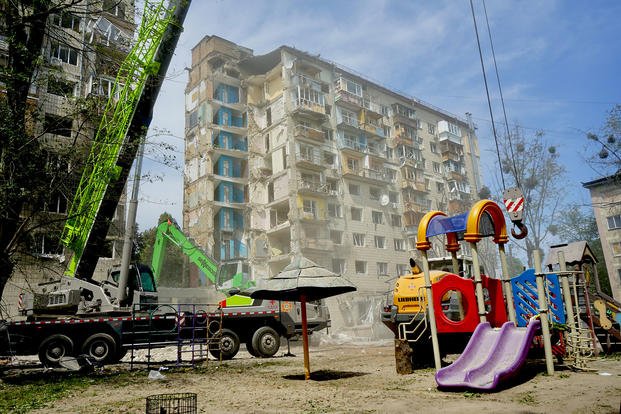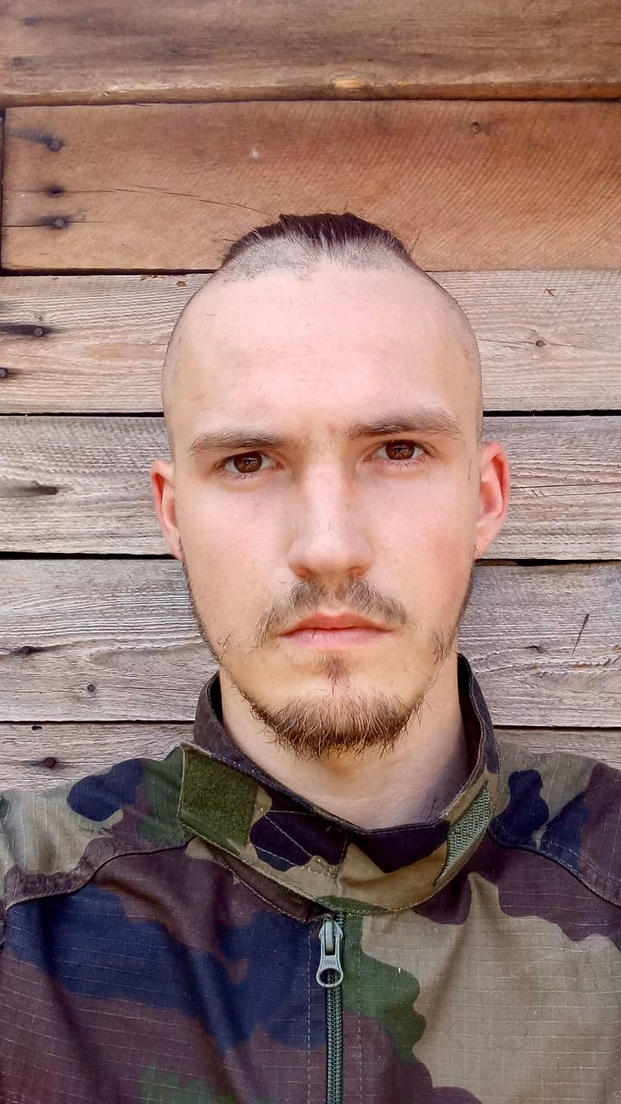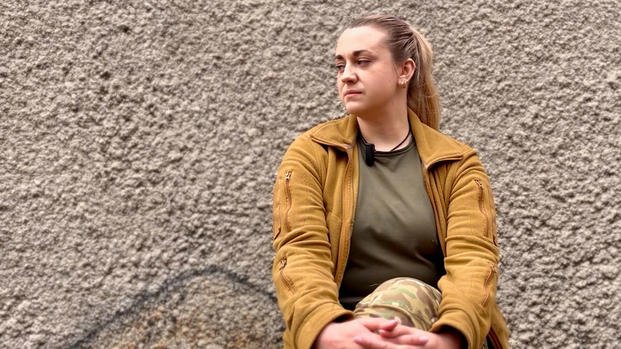DONETSK, Ukraine -- Who is fighting for Ukraine?
There is no single answer. Ukraine is a country at war, enduring a yearslong invasion by Russia, a much larger neighbor and nuclear power. Draftees and foreign fighters have joined military professionals in the country-wide commitment to survive, swelling Ukraine's armed forces to well over one million active troops.
What started as a fight predominantly waged by experienced veterans now includes more than a million conscripts, tens of thousands of women, legions of foreigners and former prisoners, and an array of other "nontraditional" soldiers.
Read Next: 'Open Cruelty': Transgender Troops Describe Indignities as They're Kicked Out of the Military
A convicted criminal turned shock trooper.
A chef drafted off the street.
An American Marine who's buried more brothers than he can count.
A surgeon now commanding medics under fire.
This is Ukraine's army now -- not only stretched thin but stretched wide, redrawing the boundaries of who serves and why.
Their reasons for fighting vary, but what today's soldiers in Ukraine share in common is a refusal to lay down their arms, even as Russian strikes on civilians intensify and the world begins to look away from their suffering.
They don't see fighting as a choice. They see it as the only option left.
Despite U.S. President Donald Trump's monthslong insistence that Kyiv and Moscow come to a deal, no real ceasefire has materialized, and the war has gotten only deadlier for Ukraine.
Military.com was in the capital on the night of June 16 when Russia launched one of its largest aerial assaults of the war, firing 440 drones and 32 missiles -- including hypersonic Kinzhals -- across the country, killing 28 people and injuring almost 200 more in the capital alone. Ukrainian President Volodymyr Zelenskyy labeled it "pure terrorism."
Ukraine continues to burn -- and to fight. While politicians debate peace from afar, its defenders remain, dug into trenches, scattered across shelled cities, holding fast against the hiss of drones and the thunder of missiles.
They don't fight for pride or even victory, but because someone has to. And for now, that someone is them. These are snapshots of their stories.
Outcasts to Army

For some of Ukraine's newest soldiers, the road to the front line started in a prison cell.
Brooks, a 26-year-old woman from Kharkiv, had wanted to join the war effort since the first Russian tanks crossed the border in 2022.
But like many women at the time, she was turned away. "There was no such opportunity," she said. "Women were not willingly taken into the army."
Shy and slim, donning a Slipknot tee and lip piercing in her off-hours, Brooks did not have the typical look of a frontline soldier. But she had the spirit.
To maintain operational security for fighters currently serving on the front lines in Ukraine, Military.com refers to all soldiers in this article by their nom de guerre only.
It wasn't until 2024 -- while serving time in prison for a crime she declined to disclose -- that the door finally opened. "At the beginning of 2022, I had this desire," she explained. "And in 2024, I had an opportunity to do something about it."
She had served just one month of a two-year sentence before enlisting under a new Ukrainian Defence Ministry policy allowing vetted prisoners to volunteer for military service in exchange for reduced sentences. Quietly introduced in May 2024, the program was born of manpower shortages and modeled in part on U.S. initiatives from World War II.
The law prohibits prisoners convicted of premeditated murder, rape, pedophilia, and a number of other serious crimes from taking part in the scheme, MP Olena Shuliak, one of the initiators of the bill in Ukraine's parliament, told national news outlet Ukrainska Pravda. Each convict wishing to become a soldier is required to obtain the approval of the civilian court, military medical board, enlistment office and recipient unit before their request can move forward.
Convicts must have no more than three years left on their sentences to apply and, as soldiers, they are offered contracts lasting until the end of martial law or total demobilization. As of April, more than 8,000 inmates -- including several women -- have joined the effort, according to the Ministry of Justice.
When asked how she ended up doing logistics for one of the country's most elite assault regiments, she said she knew her path had been unconventional but saw it as deliberate. "When I was in prison, it became a shortcut for me to end up here," she said. "It was my goal to be here."
Unlike Russia's Storm-Z penal battalions, Ukraine's convict soldiers undergo standard training and are embedded in regular units.
Having been initially turned away from service due to her gender, Brooks was surprised by the treatment she received once serving.
"In our unit, girls are treated with great loyalty," she said. "And I expected it to be harder, at least physically." She doesn't describe herself as a feminist -- not exactly -- but rejects the idea that war is just a man's job. "If you're a woman, it doesn't mean you can't do some man's work," she said. "It all depends on your abilities."
But for her, combat isn't redemption for her crimes or the chance to prove herself -- it's self-realization. "I don't regret anything at all, I'm not ashamed of anything," she said, talking about both her past and her choice to join. "And the fact that I'm doing something useful now, I'm doing it, first of all, just for myself -- because I think it's right."
Storm, another former convict who is a soldier in Brooks' unit, took a bumpier road to the front. A veteran of Ukraine's early fighting in 2022, he had served nearly two years as a grunt before a street altercation with a drug dealer landed him in prison, and not for the first time. After serving several months behind bars, Storm had the chance to rejoin the military this year under the new prisoner enlistment policy. "I signed up for service," he said. "I was called again."
Now alongside Brooks in the 1st Separate Assault Regiment, his entire perspective toward the state has changed. Initially, Storm had doubts about Ukraine's justice system and struggled with bitterness over his own experiences. "For murder, they give seven years; for stealing chocolate five," he said.
But becoming a soldier helped him reclaim his place in society -- and his purpose. Now, he chooses to put aside his former frustration with the government to focus on a deeper sense of duty to his country. "We are all men," Storm said plainly. "A man must protect his home, his family, his homeland. This is a duty."
Storm didn't feel a new sense of dignity or self from serving time for his crimes. Instead, it came from serving in the military. "I belong here," he said.
Bonds and Brotherhood

Hundreds of Americans have fought in Ukraine since Russia's full-scale invasion began, and dozens have been killed -- including 40 former servicemen. Several Americans are currently missing in action.
Tiger, a U.S. Marine veteran, has been fighting and training troops in Ukraine since early 2022. Serving with a special forces volunteer unit that has operated in combat hot spots like Bakhmut, Avdiivka, and Pokrovsk, the 39-year-old recently took a break from combat to celebrate the baptism of his infant son in Kyiv. The baby was born last year and knows nothing of life without war.
"At first, I came here to do what was right," Tiger said, referencing values honed through previous deployments to Iraq and other conflict zones. He paused before pulling out his phone to display photos of his child taking the sacrament -- cheeks rosy, eyes sparkling -- just a few weeks earlier. Then, he sighed heavily before describing the kamikaze drones he watched fly past his apartment about a week after that christening, when Russia launched a devastating aerial assault that caused hundreds of civilian casualties.
"I don't fight for Ukraine anymore," he said. He is raising a family in a city under constant Russian bombardment, and it's changed his reasons for serving. "I fight for my boys. For my family, here and in Michigan. I'm not going to let them down."
He first spoke to Military.com in May by video call from his base in eastern Ukraine, having been introduced to the publication through the English-speaking network of foreigners that has emerged in Ukraine during the war. Heavily tattooed and sporting a buzzcut, Tiger spoke sitting calmly with his hands in his lap, only occasionally glancing away to focus on the distant buzz of a drone while undertaking a quick analysis -- ours or theirs? Good news or bad?
His voice remained steady as he spoke, but the weight of fatigue and grief had etched lines around his eyes after years of fighting. "There's a cost for what we're doing. I see it every day -- I feel it every day," he said quietly. "I've buried too many guys. … And I know I'll bury more."
Since early 2025, Russia has escalated its attacks across Ukraine. Tiger's unit rotates constantly through new postings, often taking volunteer assignments. Many troops around him have gone months without genuine rest. Some break down. Others just continue, dead-eyed, coasting on skills developed over years of fighting. "It's never-ending," he said. "Welcome to hell."
That realism guides how Tiger leads new recruits during training. "They want to fight," he said. "They know what they're getting into. It's a choice, a sacrifice we're all making for the next generation."
Drafted, but Dedicated

The war came for Zmiy in September 2024. Before Russia's full-scale invasion, he was a chef in Kyiv, about to start his "dream job." But when Russian forces pressed toward the capital in early 2022, the then-25-year-old instead found himself using his culinary skills to make Molotov cocktails -- stockpiled by residents in case Russian tanks breached Kyiv's northern defenses -- and volunteering at an overwhelmed hospital treating wounded civilians.
"I knew the draft was inevitable," he told Military.com. "I just continued my civilian life, fully aware that one day I would be drafted." Ukraine has conscripted an estimated one million people since 2022, according to government statistics. Ukraine's Ministry of Defence has said the country may need up to half a million additional troops if the war continues at its current intensity -- a number that requires not just mass mobilization, but mass buy-in from the people.
When his 2024 draft notice arrived, Zmiy didn't run -- unlike more than 650,000 men who almost immediately sought refuge in Europe, or the more than 50,000 men of military age who were detained at the borders for trying to leave illegally, according to 2023 data from Eurostat.
Zmiy said he feared becoming a soldier, but let a deeper instinct win out: protecting his country and family. Even his call sign, Ukrainian for "snake," is thanks to his mom: She took in abandoned reptiles from hard-struck areas after the start of the full-scale invasion, leading Zmiy to live in a "serpentarium" for a while, he joked.
Now 28, Zmiy serves as a combat medic embedded with an infantry platoon of the 130th Separate Reconnaissance Battalion on Ukraine's southern front. He had a rapid wartime education, he said, spending about five weeks in the United Kingdom through Operation Interflex -- a British training program for Ukrainian troops -- and about a month training with his unit in Ukraine before facing the front lines.
"The drones are all over," Zmiy said. He was deployed directly into the drone-dominated nightmare at the frontline of the war, where he learned to look forward to the "good" days -- cloudy and quiet -- and how to survive the hard ones.
"On a really bad day, you will have three or four heavy casualties while defending yourself against Russians who are pressing on," he said. Ukrainian military officials now estimate that drones cause between 70% and 80% of military casualties and hardware losses, along with at least 27% of civilian injuries. "It's hide and seek. You stay low or you die."
Tens of thousands of drones now operate continuously over Ukraine, from small FPV (first-person-view) attack drones on the battlefield to larger Shahed-type suicide drones on larger infrastructure, often in civilian areas, according to the Council on Foreign Relations (CFR).
But the dystopic reality of the battlefield has not changed Zmiy's message to others facing the draft: Fear is not an excuse for inaction. "You shouldn't be afraid," he said. "War is not going anywhere. You can either be part of it or run from it. But if you run, it will catch you anyway."
He is tired, he admitted. But the war has changed him, and even as the invasion grinds toward the four-year mark, he now envisions a different life after battle, one where he can establish a veteran rehabilitation center for his brothers-in-arms.
Ukraine could have millions of combat veterans by the time peace finally arrives, presenting unprecedented challenges and costs.
"I'd offer crafting, pottery, blacksmithing -- things to help the guys recover, to forget the horrors they've been through," Zmiy said. "To help them move on."
Fighting for the Future

Kostantynivna had never planned to become a soldier. A surgeon by trade, she had previously taught first-aid workshops and volunteered at a clinic. But when Russia launched its full-scale invasion in February 2022, her skills became essential to the country's survival. She joined the next month and was soon thrust into the bloody realities of battlefield medicine.
"It's totally different. … You will not get this experience in any other situation," she said, describing the shock of first seeing the severe blast traumas and shrapnel injuries that have since become her daily cases.
Now, she is the medical commander of the 1st Separate Assault Regiment, where she oversees a team of 26 medics providing frontline care around the clock to more than 2,000 soldiers. She spends her days managing evacuation routes, coordinating field hospitals, and guiding dozens of medics through complicated cases that leave their hands and clothes crimson with reminders of the importance of their work.
She is still learning -- and teaching -- every day. Kostantynivna is part of a new generation of Ukrainian women taking on combat leadership roles, a shift driven by necessity but sustained by the realization that women are an untapped resource of high value for the military. According to Ukraine's Ministry of Defence, more than 60,000 women now serve in the armed forces, many in direct combat or command roles -- a historic transformation for the country's traditionally male-dominated forces.
In the early days, Kostantynivna was the only woman in her unit. "You sleep in one room with men. You eat with them. You literally share everything," she said. "No privacy, no gender separation. And no gear sized for women." Now, there are dozens of women in her regiment, she said, and she has no problem getting the equipment she needs.
Kostantynivna didn't sugarcoat the ongoing problems many Ukrainian women face when serving. "Being a girl, a woman in the military is difficult, especially at first," she said. "You need to prove that you can do this or that job -- and do it no worse, or even better than them."
Over time, she's seen attitudes shift dramatically. "They take you more and more seriously, so they don't treat you like a woman, or like a girl. You're just one of them."
That bond is what keeps her on the front line despite the danger and difficult social dynamics. Her eyes lit up with determination when she described saving the life of a badly wounded infantryman who had trekked miles through hostile territory to survive. "The biggest surprise for me is their desire to live," she said. "They're why I fight."
-- Katie Livingstone is a freelance correspondent currently reporting from Ukraine and Eastern Europe. A graduate of Medill and Wellesley, her work has appeared in Foreign Policy Magazine, Rolling Stone Magazine, USA Today, UPI and more. Katie speaks five languages and lives in Washington, D.C.
Related: American Veterans Fighting in Ukraine Struggle with the Politics of Abandonment
